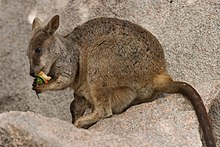Rock wallaby
| Petrogale | |
|---|---|
 |
|
| Allied rock-wallaby | |
| Scientific classification | |
| Kingdom: | Animalia |
| Phylum: | Chordata |
| Class: | Mammalia |
| Subclass: | Marsupialia |
| Order: | Diprotodontia |
| Family: | Macropodidae |
| Genus: | Petrogale |
| Species | |
|
16, see text |
|
16, see text
The rock-wallabies are the wallabies of the genus Petrogale.
The medium-sized, often colourful and extremely agile rock-wallabies live where rocky, rugged and steep terrain can provide daytime refuge. Males are slightly larger than females with a body length of up to 59 cm and a 70 cm long tail.
Rock-wallabies are nocturnal and live a fortress existence spending their days in steep, rocky, complex terrain in some kind of shelter (cave, overhang or vegetation) and ranging out into surrounding terrain at night for feed. The greatest activity occurs three hours before sunrise and after sunset.
Their reliance on refuges leads to the rock-wallabies living in small groups or colonies, with individuals having overlapping home ranges of about 15 hectares each. Within their colonies they seem to be highly territorial with a male’s territory overlapping one or a number of female territories. Even at night the wallabies do not move further than two kilometres from their home refuges.
Generally, there are three categories of habitat that the different species of rock-wallaby seem to prefer:
Suitable habitat is limited and patchy and has led to varying degrees of isolation of colonies and a genetic differentiation specific to these colonies. The rock wallaby height is ranges from 60 cm to 70 cm.
Their total numbers and range have been drastically reduced since European colonisation, with populations becoming extinct from the south.
The ongoing extinction of colonies in recent times is of particular concern, though some have argued it is blown out of proportion. In 1988, at Jenolan Caves in New South Wales for example, a caged population of 80 rock-wallabies was released to boost what was thought to be an abundant local wild population. By 1992 the total population was down to about seven. The survivors were caught and enclosed in a fox and cat-proof enclosure, and the numbers in this captive population have since begun to increase.
Scientists consider foxes the major reason for the recent extinctions, along with competing herbivores, especially goats, sheep and rabbits, diseases such as toxoplasmosis and hydatidosis, habitat fragmentation and destruction and a lower genetic health due to the increasing isolation of colonies.
...
Wikipedia
